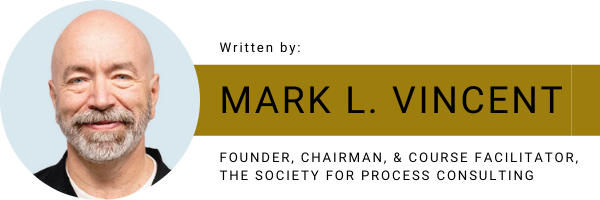 This blog post is the second of three in which Mark L. Vincent - recent author of Listening Helping Learning: Core Competencies of Process Consulting, containing a wide variety of case studies from some of our own members - will hone in on the categories of the process consulting competencies: listening, helping, and learning.
This blog post is the second of three in which Mark L. Vincent - recent author of Listening Helping Learning: Core Competencies of Process Consulting, containing a wide variety of case studies from some of our own members - will hone in on the categories of the process consulting competencies: listening, helping, and learning.
What is your definition of the word help?
For some - especially if they have been in social work or relief and development - it might be a troubling word, sounding colonialist and superior, as in I am here to help you. This can be experienced as disempowering and arrogant, especially if a need for help is assumed and was not requested.
For others it is a plea: Help me! It is an expression of helplessness. While some might make this plea in order to manipulate the sympathy of others, it more often comes after experiencing harm, incapability and even desperation. Needing to ask for help can be kin to humiliation.
For helping professions such as law or medicine, help is the work, the expertise, the offering of service that could not be gained otherwise. Here is how I can help. The question is whether it is actually help, as in aid, or a transaction because the "help" is usually priced as a service.
There are other subtle nuances around the word help, and it is good for both the Helper and Helpee to take the time to enter the experiences of each other to better understand what is meant.
For those of us committed to Process Consulting, help is something done in a partnership, especially where adaptive moves are concerned. What will actually be done in the end is not known. The Client has work to do in figuring out how to approach an opportunity or challenge. The Process Consultant is experienced in walking alongside the Client in designing and facilitating a process to figure it out. Working together, help is rendered in addressing the opportunity or challenge.
Using Ed Schein's definition: “Helping is a common yet complex process. It is an attitude, a set of behaviors, a skill, and an essential component of social life. It is the core of what we think of as teamwork and is an essential ingredient of organizational effectiveness. It is one of the most important things that leaders do and it is at the heart of change processes."
The Client and the Process Consultant are joint investors in the helping process and co-creators of any solution.
And yet, let's not too quickly gloss over the varied conceptions of what help is, and assume that just because we know a definition of help where Process Consulting is concerned, that everyone in the room will assume the same definition. Whether personally or organizationally, we don't readily ask for help - not from each other or from outside assistance - unless we feel safe and have learned to trust the players. For someone's Process Consulting practice, creating and holding safe spaces where help is performed is critical to effective Client relationships and outcomes.
So how can we recognize that the possibility of jointly rendering help is a possibility that can become a reality? The Core Competencies of Process Consulting give us some guidance.
Helping is:
- Client-centered -- Help centers on Client-defined objectives and according to the Client's definition of done.
- Client-owned and inspired -- The Client is doing the work, and wants to.
- Client-specific - Listening alongside the Client provides clarity about the unique context of the Client. Client-defined objectives are tailored to that context rather than assuming one solution works everywhere.
- Client success -- The Process Consultant and Client are able to say they did what the Client set out to do.
Helping in this way brings a Client and Process Consultant together at a point of mutual vulnerability. It is okay for us not to know what needs to be done exactly! At this intersection of mutual vulnerability the helping relationship becomes a shoulder to shoulder effort of figuring out an approach to a challenge or opportunity. And it is at this intersection that discoveries are made and new to the world solutions are born because we set aside our fears of incompetence and took up the courage to learn.
